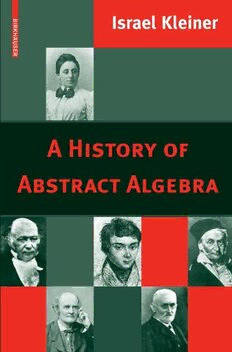
A history of abstract algebra PDF
Preview A history of abstract algebra
Israel Kleiner A History of Abstract Algebra Birkha¨user Boston • Basel • Berlin IsraelKleiner DepartmentofMathematicsandStatistics YorkUniversity Toronto,ONM3J1P3 Canada [email protected] CoverdesignbyAlexGerasev,Revere,MA. MathematicsSubjectClassification(2000):00-01,00-02,01-01,01-02,01A55,01A60,01A70, 12-03,13-03,15-03,16-03,20-03,97-03 LibraryofCongressControlNumber:2007932362 ISBN-13:978-0-8176-4684-4 e-ISBN-13:978-0-8176-4685-1 Printedonacid-freepaper. (cid:1)c2007Birkha¨userBoston Allrightsreserved.Thisworkmaynotbetranslatedorcopiedinwholeorinpartwithoutthewrit- tenpermissionofthepublisher(Birkha¨userBoston,c/oSpringerScience+BusinessMediaLLC,233 SpringStreet,NewYork,NY10013,USA),exceptforbriefexcerptsinconnectionwithreviewsor scholarlyanalysis.Useinconnectionwithanyformofinformationstorageandretrieval,electronic adaptation,computersoftware,orbysimilarordissimilarmethodologynowknownorhereafterde- velopedisforbidden. Theuseinthispublicationoftradenames,trademarks,servicemarksandsimilarterms,evenifthey arenotidentifiedassuch,isnottobetakenasanexpressionofopinionastowhetherornottheyare subjecttoproprietaryrights. 9 8 7 6 5 4 3 2 1 www.birkhauser.com (LAP/EB) With much love to my family Nava Ronen, Melissa, Leeor, Tania, Ayelet, Tamir Tia, Jordana, Jake Contents Preface ......................................................... xi Permissions ..................................................... xv 1 HistoryofClassicalAlgebra ................................... 1 1.1 Earlyroots ................................................ 1 1.2 TheGreeks................................................ 2 1.3 Al-Khwarizmi ............................................. 3 1.4 Cubicandquarticequations.................................. 5 1.5 Thecubicandcomplexnumbers.............................. 7 1.6 Algebraicnotation:VièteandDescartes ........................ 8 1.7 ThetheoryofequationsandtheFundamentalTheoremofAlgebra . 10 1.8 Symbolicalalgebra ......................................... 13 References..................................................... 14 2 HistoryofGroupTheory ...................................... 17 2.1 Sourcesofgrouptheory ..................................... 17 2.1.1 ClassicalAlgebra .................................... 18 2.1.2 NumberTheory ..................................... 19 2.1.3 Geometry........................................... 20 2.1.4 Analysis............................................ 21 2.2 Developmentof“specialized”theoriesofgroups ................ 22 2.2.1 PermutationGroups .................................. 22 2.2.2 AbelianGroups...................................... 26 2.2.3 TransformationGroups ............................... 28 2.3 Emergenceofabstractioningrouptheory ...................... 30 2.4 Consolidationoftheabstractgroupconcept;dawnofabstract grouptheory............................................... 33 2.5 Divergenceofdevelopmentsingrouptheory.................... 35 References..................................................... 38 viii Contents 3 HistoryofRingTheory ....................................... 41 3.1 Noncommutativeringtheory ................................. 42 3.1.1 ExamplesofHypercomplexNumberSystems ............ 42 3.1.2 Classification........................................ 43 3.1.3 Structure ........................................... 45 3.2 Commutativeringtheory .................................... 47 3.2.1 AlgebraicNumberTheory............................. 48 3.2.2 AlgebraicGeometry.................................. 54 3.2.3 InvariantTheory..................................... 57 3.3 Theabstractdefinitionofaring............................... 58 3.4 EmmyNoetherandEmilArtin ............................... 59 3.5 Epilogue.................................................. 60 References..................................................... 60 4 HistoryofFieldTheory ....................................... 63 4.1 Galoistheory .............................................. 63 4.2 Algebraicnumbertheory .................................... 64 4.2.1 Dedekind’sideas..................................... 65 4.2.2 Kronecker’sideas.................................... 67 4.2.3 DedekindvsKronecker ............................... 68 4.3 Algebraicgeometry......................................... 68 4.3.1 FieldsofAlgebraicFunctions .......................... 68 4.3.2 FieldsofRationalFunctions ........................... 70 4.4 Congruences .............................................. 70 4.5 Symbolicalalgebra ......................................... 71 4.6 Theabstractdefinitionofafield .............................. 71 4.7 Hensel’sp-adicnumbers..................................... 73 4.8 Steinitz ................................................... 74 4.9 Aglanceahead............................................. 76 References..................................................... 77 5 HistoryofLinearAlgebra ..................................... 79 5.1 Linearequations ........................................... 79 5.2 Determinants .............................................. 81 5.3 Matricesandlineartransformations ........................... 82 5.4 Linearindependence,basis,anddimension ..................... 84 5.5 Vectorspaces .............................................. 86 References..................................................... 89 6 EmmyNoetherandtheAdventofAbstractAlgebra ............... 91 6.1 Invarianttheory ............................................ 92 6.2 Commutativealgebra ....................................... 94 6.3 Noncommutativealgebraandrepresentationtheory .............. 97 6.4 Applicationsofnoncommutativetocommutativealgebra ......... 98 6.5 Noether’slegacy ........................................... 99 References..................................................... 101 Contents ix 7 ACourseinAbstractAlgebraInspiredbyHistory ................. 103 ProblemI:Whyis(−1)(−1)=1?................................. 104 ProblemII:Whataretheintegersolutionsofx2+2=y3?............. 105 ProblemIII:Canwetrisecta60◦ angleusingonlystraightedgeand compass? ................................................. 106 ProblemIV:Canwesolvex5−6x+3=0byradicals? .............. 107 ProblemV:“Papa,canyoumultiplytriples?” ........................ 108 Generalremarksonthecourse .................................... 109 References..................................................... 110 8 BiographiesofSelectedMathematicians ......................... 113 8.1 ArthurCayley(1821–1895) .................................. 113 8.1.1 Invariants........................................... 115 8.1.2 Groups............................................. 116 8.1.3 Matrices............................................ 117 8.1.4 Geometry........................................... 118 8.1.5 Conclusion ......................................... 119 References..................................................... 120 8.2 RichardDedekind(1831–1916)............................... 121 8.2.1 AlgebraicNumbers................................... 124 8.2.2 RealNumbers....................................... 126 8.2.3 NaturalNumbers .................................... 128 8.2.4 OtherWorks ........................................ 129 8.2.5 Conclusion ......................................... 131 References..................................................... 132 8.3 EvaristeGalois(1811–1832) ................................. 133 8.3.1 Mathematics ........................................ 135 8.3.2 Politics............................................. 135 8.3.3 Theduel............................................ 137 8.3.4 Testament .......................................... 137 8.3.5 Conclusion ......................................... 138 References..................................................... 139 8.4 CarlFriedrichGauss(1777–1855) ............................ 139 8.4.1 Numbertheory ...................................... 140 8.4.2 DifferentialGeometry,Probability,andStatistics.......... 142 8.4.3 Thediary ........................................... 142 8.4.4 Conclusion ......................................... 143 References..................................................... 144 8.5 WilliamRowanHamilton(1805–1865) ........................ 144 8.5.1 Optics.............................................. 146 8.5.2 Dynamics .......................................... 147 8.5.3 ComplexNumbers ................................... 149 8.5.4 FoundationsofAlgebra ............................... 150 8.5.5 Quaternions......................................... 152 8.5.6 Conclusion ......................................... 156 References..................................................... 156 x Contents 8.6 EmmyNoether(1882–1935) ................................. 157 8.6.1 EarlyYears ......................................... 157 8.6.2 UniversityStudies ................................... 158 8.6.3 Göttingen........................................... 159 8.6.4 NoetherasaTeacher ................................. 160 8.6.5 BrynMawr ......................................... 161 8.6.6 Conclusion ......................................... 162 References..................................................... 162 Index........................................................... 165 Preface Mygoalinwritingthisbookwastogiveanaccountofthehistoryofmanyofthebasic concepts, results, and theories of abstract algebra, an account that would be useful forteachersofrelevantcourses,fortheirstudents,andforthebroadermathematical public. Thecoreofafirstcourseinabstractalgebradealswithgroups,rings,andfields. ThesearethecontentsofChapters2,3,and4,respectively.Butabstractalgebragrew outofanearlierclassicaltradition,whichmeritsanintroductorychapterinitsown right (Chapter 1). In this tradition, which developed before the nineteenth century, “algebra” meant the study of the solution of polynomial equations. In the twenti- ethcenturyitmeantthestudyofabstract,axiomaticsystemssuchasgroups,rings, and fields. The transition from “classical” to “modern” occurred in the nineteenth century.Abstractalgebracameintoexistencelargelybecausemathematicianswere unabletosolveclassical(pre-nineteenth-century)problemsbyclassicalmeans.The classicalproblemscamefromnumbertheory,geometry,analysis,thesolvabilityof polynomialequations,andtheinvestigationofpropertiesofvariousnumbersystems. Amajorthemeofthisbookistoshowhow“abstract”algebrahasariseninattemptsto solvesomeofthese“concrete”problems,thusprovidingconfirmationofWhitehead’s paradoxicaldictumthat“theutmostabstractionsarethetrueweaponswithwhichto controlourthoughtofconcretefact.”Putanotherway:thereisnothingsopractical asagoodtheory. Although linear algebra is not normally taught in a course in abstract algebra, itsevolutionhasoftenbeenconnectedwiththatofgroups,rings,andfields.And,of course, vector spaces are among the fundamental notions of abstract algebra. This warrantsa(short)chapteronthehistoryoflinearalgebra(Chapter5). Abstractalgebraisessentiallyacreationofthenineteenthcentury,butitbecamean independentandflourishingsubjectonlyintheearlydecadesofthetwentieth,largely throughthepioneeringworkofEmmyNoether,whohasbeencalled“thefather”of abstractalgebra.ThusthechapteronNoether’salgebraicwork(Chapter6). Itismyfirmbelief,buttressedbymyownteachingexperience,thatthehistoryof mathematicscanmakeanimportantcontributiontoour—teachers’andstudents’— understanding and appreciation of mathematics. It can act as a useful integrating
